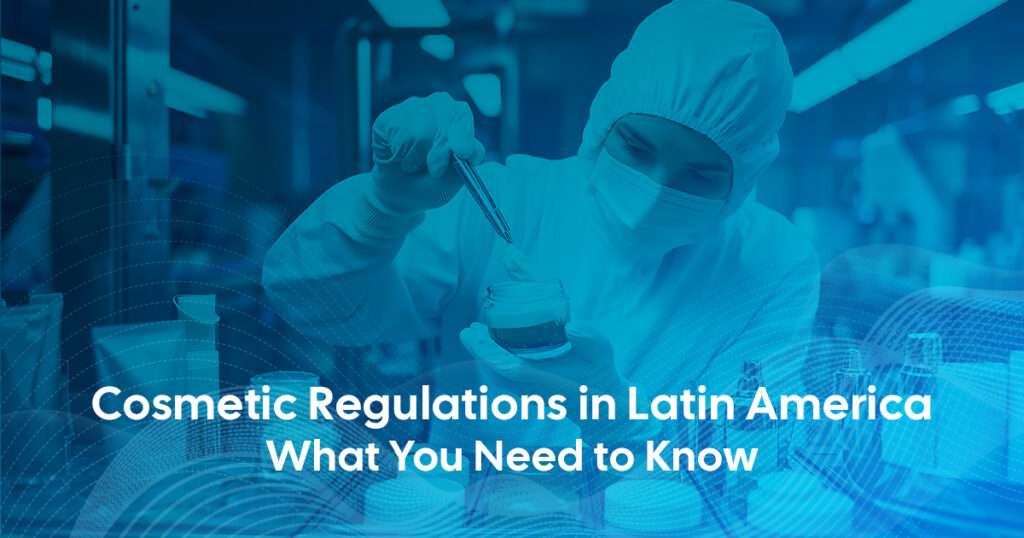
Latin America (LATAM) is one of the fastest-growing regions for cosmetics, with annual growth rates often surpassing global averages. Among its key markets, Brazil stands out as the largest, followed closely by Mexico, Argentina, Colombia, and others. However, for companies aiming to manufacture or export cosmetic products to LATAM, understanding the region’s fragmented regulatory processes poses a significant challenge. This blog explores the regulatory frameworks for cosmetics in major Latin America and highlights key considerations for businesses planning market entry or expansion.
Brazil – ANVISA
Brazil’s National Health Surveillance Agency (ANVISA) regulates cosmetics under one of the most structured frameworks in the region. Cosmetics are categorized based on their risk:
- Category 1 (Lower Risk): Products such as soap, shampoo, and lipstick with minimal safety concerns. These only require notification through the ANVISA Notification System.
- Category 2 (Higher Risk): Products with active claims or specific applications (e.g., sunscreens, anti-aging creams, children’s products) that require formal registration, detailed safety documentation, and efficacy data.
Additionally, ANVISA enforces strict guidelines on labeling, permissible ingredients, GMP compliance, and stability testing.
Mexico – COFEPRIS
The Federal Commission for Protection against Sanitary Risk (COFEPRIS) oversees cosmetic regulation in Mexico. The system is based on notification rather than pre-market approval, making the process relatively streamlined.
Cosmetics are defined as products intended for external use on the human body to clean, perfume, change appearance, or correct body odors. Any product making therapeutic claims is considered a medicine and regulated accordingly.
COFEPRIS has aligned many of its regulations with international standards but enforces specific requirements including labeling in Spanish and local representation for foreign companies.
Colombia – INVIMA and the Andean Community Framework
In Colombia, cosmetic products are regulated by the National Institute for Drug and Food Surveillance (INVIMA), under national laws and the Andean Community Decision 833. This Decision facilitates partial harmonization of cosmetic regulations across Bolivia, Colombia, Ecuador, and Peru.
Under this framework:
- A cosmetic product registered in one member state can be marketed in other member countries through a simplified notification process.
- Despite regional coordination, local requirements such as labeling, shelf-life, and GMP documentation must still be met.
Argentina – ANMAT
Argentina’s National Administration of Drugs, Foods, and Medical Devices (ANMAT) requires that all cosmetic products be registered before commercialization. A distinctive feature of ANMAT’s system is its strong emphasis on Good Manufacturing Practices (GMP) for production facilities.
Additionally, manufacturers must conduct stability studies to demonstrate that their products maintain physical, chemical, and microbiological stability under recommended storage conditions.
Harmonization Efforts in the LATAM Region
Efforts are underway to reduce regulatory complexity through regional harmonization initiatives:
MERCOSUR Framework
The Southern Common Market (MERCOSUR) — comprising Brazil, Argentina, Paraguay, and Uruguay — has adopted a common regulatory structure through Resolution GMC 110/94, classifying cosmetics by risk:
- Type I (Lower Risk): Products with simple, general-use functions.
- Type II (Higher Risk): Products requiring substantiation of safety and efficacy due to their specialized claims.
Although a unified framework exists, implementation differs by country, requiring localized strategies.
Andean Community Decision 833
As outlined earlier, Decision 833 provides a pathway for cross-border registration of cosmetics within the Andean countries. While the process allows for reduced duplication, individual countries maintain autonomy over specific regulatory elements like labeling language, product presentation, and documentation format.
Trends and Future Directions
Cosmetic regulations in LATAM are evolving, with new trends shaping the future landscape:
- Sustainability Focus: Increasing scrutiny on microplastics, palm oil, and packaging waste.
- Animal Testing Restrictions: Several countries are phasing out or banning animal testing for cosmetics.
- Digitalization: Shift toward e-submissions and online regulatory platforms.
- Ingredient Restrictions: Gradual alignment with EU ingredient bans and restrictions, especially for preservatives and colorants.
Conclusion
Latin America’s cosmetics market offers significant growth potential, but companies must navigate a complex regulatory environment characterized by both regional harmonization and country-specific rules.
Understanding these nuances is critical for successful market entry. While frameworks like MERCOSUR and the Andean Community offer opportunities for streamlined access, local variations still demand customized strategies.
About DDReg
At DDReg, we support cosmetic manufacturers and exporters with end-to-end regulatory solutions tailored to LATAM markets. From product classification and notification to documentation, GMP advisory, and labeling compliance — we help ensure your products meet local and regional standards efficiently.
Ready to expand your cosmetics business into Latin America? Contact us today for regulatory guidance and customized market access solutions.
Read more insights from DDReg experts here: Post-Market Surveillance (PMS) in Medical Devices: USA & EU
